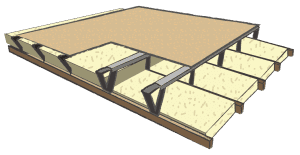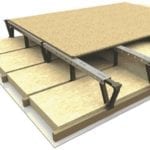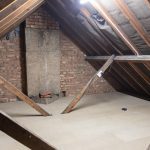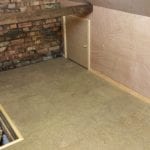
Boarding and insulation are perhaps the two most important things you can do for your loft.
Unfortunately, they’re not obviously compatible, since the government-recommended depth of insulation tends to come well above the joists. This makes it difficult to lay boards and keep the insulation effective.
Fortunately, there is a solution.
The pros and cons of insulating your loft
The advantages of loft insulation are many and obvious. As much as a third of the heat in an average house can escape through an uninsulated loft. Insulation reduces it to the extent that you can save around 25% on your energy bills, as well as significantly reducing your carbon footprint.
So are there any disadvantages? Not really, but it is an inconvenience that in many lofts, especially in older houses, the space between the joists isn’t deep enough to take the 270mm of insulation specified by government regulations. This means, if you try to lay boarding directly on the joists, you’re compressing the insulation, which can reduce ventilation and increase the risk of condensation.
Read more: our ultimate guide to loft insulation.
The pros and cons of boarding your loft
With space at a premium in many homes, your loft is a valuable asset. A full conversion into living space can be complex and expensive, but your loft is valuable as storage space. Boarding it over gives you easy access both to store and to retrieve your possessions — you don’t have to balance precariously on the joists.
Again, the only real con is the danger of compressing your insulation. The ideal solution would be to lay the boards at a higher level than the joists — and that’s certainly possible.
Read more: our ultimate guide to loft boarding and flooring.
The LoftZone StoreFloor System
The LoftZone™ StoreFloor system is the most efficient method. Its modular structure allows the floor to be raised substantially above the joists without being any less secure and firm. This protects the insulation, allowing it to breathe and the air to circulate freely under the boards.
Strong and lightweight, the system even allows adjustment for variations in the height of the joists. It’s recommended by the government for new builds, as well as being equally effective for older houses. It’s approved by the Carbon Trust, as well as meeting the British Standard 6399-1:1996 for minimum imposed floor load requirements.
The LoftZone™ StoreFloor system is best installed by professionals, to ensure perfect fitting. Nevertheless, it’s fairly straightforward to fit, so it shouldn’t be expensive, time-consuming or disruptive. Get in touch with us if you want to know more about it.
Was this post useful? Here are some other’s you might like...






